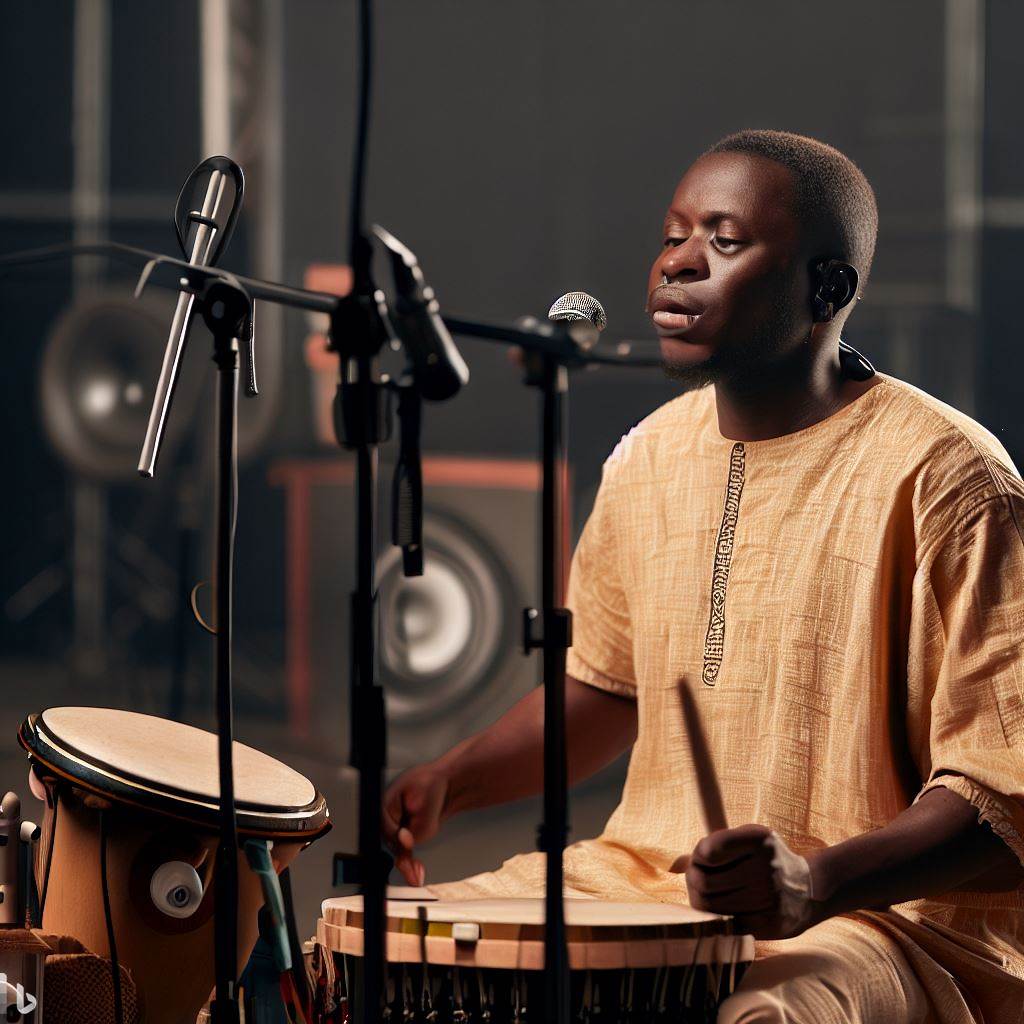Creating Authentic Sounds: Tips from Top Nigerian Foley Artists
Last Updated on August 26, 2023
Introduction
Foley artists play a crucial role in the film industry by creating authentic sounds to enhance the viewing experience. We’ll be discussing Tips for Creating Authentic Foley Sounds.
Foley artists use various objects to reproduce sounds that cannot be recorded live during filming.
Authentic sounds bring a sense of realism and immersion to the audience, making it easier for them to connect emotionally with the story and characters.
In this blog post, we will dive into the world of Nigerian Foley artists, exploring their tips and expertise in creating authentic sounds. We will uncover their techniques, equipment, and creative process.
Background on Nigerian Foley Artists
Nigeria, also known as Nollywood, is home to a vibrant film industry that has gained international recognition in recent years.
With its rich cultural heritage and diverse population, Nigeria has produced some of the most talented foley artists in the world.
Overview of the Nigerian film industry (Nollywood)
Nollywood is the second-largest film industry in the world, surpassing Hollywood in terms of the number of films produced annually.
It is known for its unique storytelling style, often incorporating elements of traditional Nigerian culture and folklore.
Nollywood films are typically low-budget productions, with limited resources and time constraints.
Despite these challenges, Nigerian filmmakers have found innovative ways to create authentic sounds that enhance the overall viewing experience.
Rise of Foley artists in Nigeria
Foley artists are responsible for creating and recording sound effects in post-production. They add depth and realism to the visuals, making viewers feel more immersed in the film’s narrative.
In Nigeria, the demand for skilled foley artists has been on the rise, thanks to the growing popularity of Nollywood films.
Tips from top Nigerian Foley artists
- Immerse yourself in the story: Understanding the narrative and emotional arc of a film is crucial for creating authentic sounds that resonate with the audience.
- Use locally sourced props: Nigerian foley artists often utilize objects readily available in their surroundings to create unique and realistic sound effects.
- Experiment with different recording techniques: Foley artists in Nigeria are known for their resourcefulness. They explore unconventional methods to capture sounds, resulting in a distinctive and original sound design.
- Pay attention to cultural nuances: Nigerian films often showcase cultural elements, and foley artists must be sensitive to these nuances when creating sound effects.
- Collaborate with other artists: Foley artists frequently work closely with directors, sound designers, and composers to ensure that the sound design aligns with the overall vision of the film.
- Keep up with technology: Nigerian foley artists embrace advancements in sound editing software and equipment to enhance the quality of their work.
- Continuously learn and evolve: Foley artists understand the importance of honing their craft. They stay updated on industry trends and techniques through workshops, training programs, and collaborations with international artists.
- Embrace authenticity: Nigerian foley artists emphasize the importance of staying true to the culture and environment depicted in the film. They strive to create sounds that resonate with local audiences while also appealing to international viewers.
- Be versatile: Foley artists in Nigeria often work on a wide range of films, from romantic comedies to action-packed thrillers. They adapt their skills and techniques to suit the specific genre and aesthetic of each project.
All in all, Nigerian foley artists play a vital role in the success of Nollywood films, contributing their unique creativity and expertise to create authentic sounds.
Through their craft, they elevate the cinematic experience and help Nigerian films make an impact on the global stage.
Read: Training Opportunities for Aspiring Foley Artists in Nigeria
Understanding the importance of sound in storytelling
- Sound is a powerful tool in storytelling as it has the ability to enhance emotions and immerse the audience.
- When used effectively, sound can bring a scene to life and make it more memorable.
- For example, in horror movies, the sound of a creaking door or footsteps in an empty hallway can create tension and fear.
- Interview with Nigerian Foley artist, Adeola Adetola, reveals the significance of sound design in Nigerian movies.
Creating authentic sounds through Foley artistry
- Foley artists use everyday objects to create sounds that match the actions happening on screen.
- By using props such as coconuts for horse hooves or crinkling aluminum foil for fire, they can create realistic sound effects.
- These sounds are then carefully integrated into the film during post-production.
- Interview with Nigerian Foley artist, Chizoba Nwokike, provides insights into the creative process of Foley artistry.
Paying attention to details for a truly authentic experience
- Foley artists understand the importance of paying attention to small details in order to create an authentic sound.
- They listen closely to the movements and actions of characters and replicate those sounds using various techniques.
- For instance, to recreate the sound of walking on different surfaces, they experiment with different materials, such as sand or gravel.
- By focusing on these details, Foley artists ensure that the sounds they create are in sync with the visuals.
Collaboration and experimentation in sound design
- Successful sound design requires collaboration between Foley artists, sound editors, and directors.
- They work together to create a cohesive sound experience that enhances the overall storytelling.
- Experimentation is a key element in sound design, as it allows for the discovery of unique and innovative sounds.
- Nigerian Foley artist, Ifeoluwa Adenuga, highlights the importance of trying new techniques and materials to achieve desired sounds.
The impact of powerful sound design in iconic movie scenes
- Several iconic movie scenes have relied heavily on impactful sound design to leave a lasting impression on the audience.
- The shower scene in Alfred Hitchcock’s “Psycho” is a prime example, with the screeching violin sound becoming synonymous with horror.
- Other examples include the roar of Godzilla or the lightsaber sounds in the “Star Wars” franchise.
- These iconic sounds have become part of pop culture and showcase the importance of sound in storytelling.
In fact, sound plays a crucial role in storytelling, enhancing emotions, and immersing the audience. Nigerian Foley artists contribute to this process by creating authentic sounds through their artistry.
By paying attention to details, collaborating, and experimenting, they bring stories to life with their sound design.
The impact of powerful sound design can be seen in iconic movie scenes that have become ingrained in popular culture.
So next time you watch a movie, pay attention to the sounds – they have the power to transport you into a whole new world.
Read: Foley in Nigeria: Exploring the Demand in Local Film Industry
Utilizing Indigenous Sounds and Instruments
When it comes to creating authentic sounds, one of the most effective tips from top Nigerian Foley artists is to utilize indigenous sounds and instruments.
Nigeria is a country with a rich cultural heritage and a diverse range of local sounds, which can elevate the authenticity of any project.
Introduction to the Uniqueness of Nigerian Culture and Traditions
Nigeria is known for its vibrant culture and traditions that have been passed down through generations.
From the rhythmic beats of traditional drumming to the melodic tunes of local instruments, Nigerian music has a distinct sound that resonates with its people.
By understanding and appreciating the uniqueness of Nigerian culture and traditions, Foley artists can accurately capture the essence of a Nigerian setting in their sound production.
This requires a deep dive into the various types of music, instruments, and sounds that are native to the country.
How Incorporating Local Sounds Can Add Depth and Authenticity
When Nigerian Foley artists incorporate local sounds into their work, it adds a layer of depth and authenticity that cannot be replicated.
These indigenous sounds have a way of transporting the listener to the heart of Nigeria, creating a truly immersive experience.
By using local sounds, such as the mesmerizing rhythms of the talking drum or the soul-stirring melodies of the kalimba, Foley artists can create a sonic landscape that accurately represents the cultural roots of the scene or setting.
This attention to detail elevates the overall quality of the sound production.
Interviews with Top Nigerian Foley Artists Discussing Their Process of Using Indigenous Sounds
To gain further insight into the process of utilizing indigenous sounds and instruments, we spoke to some of the top Nigerian Foley artists in the industry.
They provided valuable tips and shared their personal experiences in incorporating local sounds into their work.
Kelechi Okpara, a renowned Foley artist, emphasized the importance of field recordings.
He explained how he would venture into different parts of Nigeria to capture the authentic sounds of everyday life, such as bustling markets, nature sounds, and traditional ceremonies.
Another artist, Adaobi Nwachukwu, highlighted the significance of collaborating with local musicians and artists.
She would often work closely with talented instrumentalists who played traditional Nigerian instruments, ensuring that their performances were accurately captured in the sound production.
These interviews shed light on the passion and dedication that Nigerian Foley artists bring to their craft.
Through their artistic choices, they strive to preserve the cultural heritage of Nigeria and showcase it to a global audience.
By understanding and appreciating the uniqueness of Nigerian culture and traditions, these artists are able to capture the essence of Nigeria in their work.
Through interviews with top Nigerian Foley artists, we have gained valuable insights into the process of using local sounds.
Their dedication and attention to detail in capturing the authentic sounds of Nigeria are commendable and contribute to the overall authenticity of sound production.
Through their work, these Foley artists are ambassadors of Nigerian culture, spreading its richness and uniqueness to the world.
So, the next time you watch a Nigerian film or listen to a Nigerian song, pay close attention to the background sounds.
You’ll be amazed at the level of detail and authenticity that indigenous sounds can bring to the overall experience.
Read: Essential Tools for a Foley Artist: Nigerian Perspective

Experimenting with Everyday Objects
Foley artists are known for their creativity and resourcefulness in using everyday objects to create unique and authentic sounds.
By thinking outside the box and experimenting with unconventional methods, they are able to bring to life the sounds that we see on screen.
Here are some tips and stories from top Nigerian Foley artists on how they make use of everyday objects to enhance their craft.
How Foley Artists Creatively Use Objects to Create Sounds
Foley artists understand that in order to create realistic sounds, they need to find objects that can mimic the desired sound effect.
This means thinking beyond the conventional tools typically used in sound production.
By exploring their surroundings and experimenting with various objects, Foley artists can find the perfect match for the sound they are trying to recreate.
For example, to create the sound of footsteps on gravel, a Foley artist might use a tray filled with pebbles and walk on it to produce the desired effect.
They might also experiment with different types of shoes or even try using a combination of objects to achieve the desired sound.
Stories from Nigerian Foley Artists
Nigerian Foley artists have their fair share of stories on how they discovered unique objects for sound effects.
One Foley artist, Ahmed, recalls a time when he needed to create the sound of a breaking glass bottle.
Instead of using an actual glass bottle, he discovered that by smashing a hollow coconut against a hard surface, he could produce a similar sound effect that was both realistic and unique.
Another Foley artist, Nneka, shares her experience of trying to create the sound of a thunderstorm.
Instead of relying solely on traditional sound effects libraries, she decided to experiment with different objects to capture the essence of a storm.
She found that by crumpling a plastic bag and shaking it vigorously, she could recreate the sound of thunder and lightning in a way that felt more authentic.
Benefits of Using Unconventional Methods
Using unconventional methods and everyday objects in Foley work offers several benefits. Firstly, it allows Foley artists to create sounds that are truly unique and authentic.
By using objects that are not typically associated with specific sound effects, they can provide a fresh perspective and add depth to their work.
Secondly, experimenting with everyday objects can save time and money. Foley artists often work under tight deadlines and limited budgets.
Instead of searching for specific props or relying solely on expensive equipment, they can make use of easily accessible objects to achieve the desired effects.
Lastly, using unconventional methods challenges Foley artists to think creatively and expand their repertoire.
By exploring new ways of creating sounds, they can push the boundaries of their craft and continuously improve their skills.
In short, experimenting with everyday objects is a valuable technique for Foley artists in creating authentic sounds.
By thinking creatively and exploring unconventional methods, they can discover unique objects that enhance their craft.
Nigerian Foley artists have showcased their resourcefulness and ingenuity in finding the perfect match for sound effects.
By using everyday objects, they can create sounds that are truly authentic, save time and money, and continually push the boundaries of their art.
Read: Salaries and Career Progression for Foley Artists in Nigeria
Collaboration between Foley artists and filmmakers
Collaboration is key in the world of Foley artistry and filmmaking. Effective communication and understanding between the two parties are crucial for achieving authentic and immersive sounds in movies.
In this blog section, we will explore the importance of collaboration and share examples of successful partnerships between Nigerian Foley artists and filmmakers.
We will also hear from industry professionals who will share their experiences and lessons learned from these collaborations.
Importance of communication and understanding between the two parties
Collaboration between Foley artists and filmmakers is essential because it allows for a cohesive and harmonious working relationship.
Effective communication and understanding help both parties to achieve a unified vision and deliver the desired sound effects for the film.
Examples of successful collaborations between Nigerian Foley artists and filmmakers
One example of a successful collaboration is between renowned Nigerian Foley artist, Tunde Adekola, and filmmaker, Ngozi Okonjo-Iweala.
Adekola and Okonjo-Iweala worked together on the movie “Half of a Yellow Sun.”
Through their collaboration, they were able to create sounds that accurately depicted the Nigerian Civil War, providing a more immersive experience for the audience.
Speaking about their collaboration, Adekola said, “It was crucial for me to understand Ngozi’s vision for the film.
We had numerous conversations where she explained how she wanted the audience to feel through the sounds. This understanding allowed me to create sounds that enhanced the emotional impact of the film.”
Another successful collaboration took place between Foley artist, Bola Belajo, and filmmaker, Kunle Afolayan, on the movie “October 1.”
Belajo and Afolayan worked closely together to capture the sounds of Nigeria in the 1960s, ensuring authenticity in the film.
This collaboration not only added to the realism of the movie but also highlighted the cultural heritage of Nigeria.
Reflecting on their collaboration, Afolayan said, “Bola’s attention to detail and her dedication to capturing the essence of the era was remarkable.
She researched extensively and brought incredible insight to the table. We trusted each other’s expertise, which made the collaboration seamless.”
Interviews with both Foley artists and filmmakers on their experiences and lessons learned
In interviews with other Foley artists and filmmakers, a common sentiment echoed is the importance of trust and open communication.
Both parties must have a shared understanding of the film’s intended emotional impact and work together to achieve it through sound.
Foley artist Chika Williams emphasized the significance of trust, saying, “Filmmakers must trust Foley artists to bring their vision to life through sound.
Likewise, Foley artists must trust filmmakers to provide guidance and feedback that aligns with the film’s narrative.”
Collaboration between Foley artists and filmmakers is a continuous learning process. It requires adaptability, patience, and a willingness to experiment.
Through trial and error, both parties can discover new techniques and approaches to sound design that enhance the film.
In essence, collaboration between Foley artists and filmmakers is crucial for creating authentic sounds in movies.
The importance of communication and understanding cannot be overstated.
Successful collaborations between Nigerian Foley artists and filmmakers, such as those mentioned, serve as examples of the positive impact collaboration can have on the final product.
By fostering a collaborative environment, both parties can learn from one another, improving their craft and creating more immersive cinematic experiences.
Conclusion
The tips provided by top Nigerian Foley artists offer valuable insights into the art of creating authentic sounds in filmmaking.
These professionals emphasize the importance of paying attention to detail, using real-life objects for sound effects, and experimenting with different techniques.
Authentic sounds enhance the overall viewing experience, immersing the audience in the story and enhancing emotional engagement.
They bring life to the visuals and contribute to the storytelling process, making a film more believable and captivating.
If you aspire to be a Foley artist, don’t be afraid to think outside the box and experiment with different sounds.
Learning from experienced professionals in the field can provide valuable guidance and insights to improve your skills.
Remember, creating authentic sounds is an art form that requires dedication, practice, and a deep understanding of the emotional impact sound can have in filmmaking.
So, embrace your creativity, keep refining your skills, and never stop exploring the possibilities in the world of Foley art.


